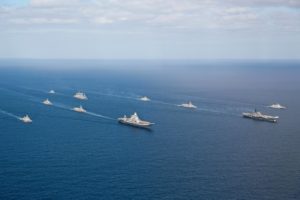
India is industrializing her naval potency at a rapid pace to attain a superior “Blue Water Navy” covering the India Ocean. Nearly 90 percent of the Indian trade is carried out via the sea route, which requires India to expand her naval power both to protect her national interests and also create military hegemony in the region and beyond.
The Indian Navy recently took delivery of the first domestically assembled long-range surface-to-air missile system (LRSAM) on August 27 last month. The Barak-8 (first LRSAM) is indigenously produced by Indian missile maker Bharat Dynamic with the assistance of Indian MoD’, Defense Research and Development Organization (DRDOs) in collaboration with a production line set up by Israeli defense contractors IAI and its subsidiary Rafael in India. LRSAM is designed to deal with incoming airborne threats with a range of 90-150 kilometers and is equipped with advanced phased-array radar, command and control, mobile launchers and missiles with increasing radio frequency (RF) searchers.
India’s urge to advance blue water proficiencies is perceived as intimidation by other countries in the neighborhood. India’s superiority in this area makes Pakistan nervous, and thus a potential arms race is highly plausible. Materializing India’s nuclear ambitions that would include a second-strike capability will disrupt the nuclear deterrence equation in the region.
According to an estimate, 2016 Indian Naval assets include 79,023 personnel and a large fleet comprising of 2 aircraft carriers, 1GAH amphibious transport dock, 9 landing ship tanks, 14 frigates, 10 destroyers, 1 nuclear-powered submarine and 14 conventionally powered submarines, 25 corvettes, 7 minesweeping vessels, 47 patrol vessels, 4 fleet tankers, numerous auxiliary ships, 8 maritime reconnaissance and anti-submarine aircraft purchased from Boeing for $ 2.1 billion in 2009 and approved an order for 4 more aircraft.
India’s naval budget for the upcoming decade is estimated at $61 billion which will substantially increase her capabilities. India has grown her indigenously built assets including the development of capacity through joint collaborations with other nations. India plans to build a 160 plus-ship navy, three aircraft carrier battle groups, 40 warships and submarines including stealth destroyers, anti-submarine corvettes and stealth frigates, INS Vikrant due to be inducted by 2018-19, induction of MIG-29K multirole aircraft and Kamov-28 and 31 helicopters to the position from its aircraft carriers as per 2022 plan. These acquisitions would immensely improve Indian reconnaissance capabilities and would provide the Indian Navy strategic outreach in the Indian Ocean.
According to 2009 updated Indian Maritime Doctrine, Indian Navy will put under her control all the choke points, significant islands, and trade routes, the Indian Ocean, Arabian Sea and in the Bay of Bengal. This vision is put forward for the Indian Navy by 2025. India aims to operationalize its naval force in combination with the United States. Taking benefit from United States presence in the region, India is trying to counter Chinese maritime influence while developing her naval ambitions.
The more important point to ponder is that India set to nuclearize the Indian Ocean to deter other nations to play a major role in the area. Pakistan cannot counter Indian supremacy but must improve its effective nuclear deterrence as a defense criteria. Indian naval nuclear advancement will qualitatively modify the strategic equilibrium between India and Pakistan. To counter Indian supremacy, Pakistan must develop her capabilities which in turn will result in a fierce arms race.
It is recommended that Pakistan should keenly watch the Indian naval transformation and expand her indigenous defense manufacturing to meet the requirements of the Pakistan Navy. Pakistan’s poor economic resources do not allow procurement of new weapon systems from industrialized countries. Pakistan must boost her joint ventures with countries like China, Germany, and France to grow her navy’s strength despite the weak economy. Pakistan navy should also explore reconnaissance proficiencies and invite countries to participate in joint naval exercises. These activities are necessary to enhance her operative defense capabilities at sea to counter intimidation from her adversaries.
